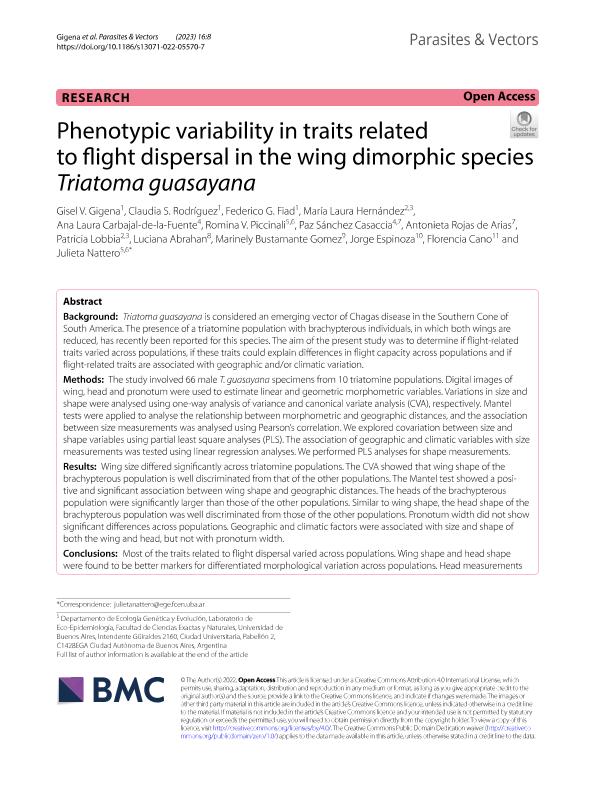Artículo
Phenotypic variability in traits related to flight dispersal in the wing dimorphic species Triatoma guasayana
Gigena, Gisel Virginia ; Rodriguez, Claudia Susana
; Rodriguez, Claudia Susana ; Fiad, Federico Gastón; Hernández, María Laura
; Fiad, Federico Gastón; Hernández, María Laura ; Carbajal de la Fuente, Ana Laura
; Carbajal de la Fuente, Ana Laura ; Piccinali, Romina Valeria
; Piccinali, Romina Valeria ; Sánchez Casaccia, María de la Paz
; Sánchez Casaccia, María de la Paz ; Rojas de Arias, Antonieta; Lobbia, Patricia Alejandra
; Rojas de Arias, Antonieta; Lobbia, Patricia Alejandra ; Abrahan, Luciana Beatriz
; Abrahan, Luciana Beatriz ; Bustamante Gomez, Marinely; Espinoza, Jorge; Cano, Florencia; Nattero, Julieta
; Bustamante Gomez, Marinely; Espinoza, Jorge; Cano, Florencia; Nattero, Julieta
 ; Rodriguez, Claudia Susana
; Rodriguez, Claudia Susana ; Fiad, Federico Gastón; Hernández, María Laura
; Fiad, Federico Gastón; Hernández, María Laura ; Carbajal de la Fuente, Ana Laura
; Carbajal de la Fuente, Ana Laura ; Piccinali, Romina Valeria
; Piccinali, Romina Valeria ; Sánchez Casaccia, María de la Paz
; Sánchez Casaccia, María de la Paz ; Rojas de Arias, Antonieta; Lobbia, Patricia Alejandra
; Rojas de Arias, Antonieta; Lobbia, Patricia Alejandra ; Abrahan, Luciana Beatriz
; Abrahan, Luciana Beatriz ; Bustamante Gomez, Marinely; Espinoza, Jorge; Cano, Florencia; Nattero, Julieta
; Bustamante Gomez, Marinely; Espinoza, Jorge; Cano, Florencia; Nattero, Julieta
Fecha de publicación:
12/2023
Editorial:
BioMed Central
Revista:
Parasites and Vectors
ISSN:
1756-3305
Idioma:
Inglés
Tipo de recurso:
Artículo publicado
Clasificación temática:
Resumen
Background: Triatoma guasayana is considered an emerging vector of Chagas disease in the Southern Cone of South America. The presence of a triatomine population with brachypterous individuals, in which both wings are reduced, has recently been reported for this species. The aim of the present study was to determine if flight-related traits varied across populations, if these traits could explain differences in flight capacity across populations and if flight-related traits are associated with geographic and/or climatic variation. Methods: The study involved 66 male T. guasayana specimens from 10 triatomine populations. Digital images of wing, head and pronotum were used to estimate linear and geometric morphometric variables. Variations in size and shape were analysed using one-way analysis of variance and canonical variate analysis (CVA), respectively. Mantel tests were applied to analyse the relationship between morphometric and geographic distances, and the association between size measurements was analysed using Pearson’s correlation. We explored covariation between size and shape variables using partial least square analyses (PLS). The association of geographic and climatic variables with size measurements was tested using linear regression analyses. We performed PLS analyses for shape measurements. Results: Wing size differed significantly across triatomine populations. The CVA showed that wing shape of the brachypterous population is well discriminated from that of the other populations. The Mantel test showed a positive and significant association between wing shape and geographic distances. The heads of the brachypterous population were significantly larger than those of the other populations. Similar to wing shape, the head shape of the brachypterous population was well discriminated from those of the other populations. Pronotum width did not show significant differences across populations. Geographic and climatic factors were associated with size and shape of both the wing and head, but not with pronotum width. Conclusions: Most of the traits related to flight dispersal varied across populations. Wing shape and head shape were found to be better markers for differentiated morphological variation across populations. Head measurements also varied in accordance with this condition. Geographic and climatic variables were associated with most of the flight-related traits.
Archivos asociados
Licencia
Identificadores
Colecciones
Articulos(CRILAR)
Articulos de CENTRO REGIONAL DE INV. CIENTIFICAS Y TRANSFERENCIA TECNOLOGICA DE ANILLACO
Articulos de CENTRO REGIONAL DE INV. CIENTIFICAS Y TRANSFERENCIA TECNOLOGICA DE ANILLACO
Articulos(IEGEBA)
Articulos de INSTITUTO DE ECOLOGIA, GENETICA Y EVOLUCION DE BS. AS
Articulos de INSTITUTO DE ECOLOGIA, GENETICA Y EVOLUCION DE BS. AS
Articulos(IIBYT)
Articulos de INSTITUTO DE INVESTIGACIONES BIOLOGICAS Y TECNOLOGICAS
Articulos de INSTITUTO DE INVESTIGACIONES BIOLOGICAS Y TECNOLOGICAS
Articulos(SEDE CENTRAL)
Articulos de SEDE CENTRAL
Articulos de SEDE CENTRAL
Citación
Gigena, Gisel Virginia; Rodriguez, Claudia Susana; Fiad, Federico Gastón; Hernández, María Laura; Carbajal de la Fuente, Ana Laura; et al.; Phenotypic variability in traits related to flight dispersal in the wing dimorphic species Triatoma guasayana; BioMed Central; Parasites and Vectors; 16; 1; 12-2023; 1-14
Compartir
Altmétricas



